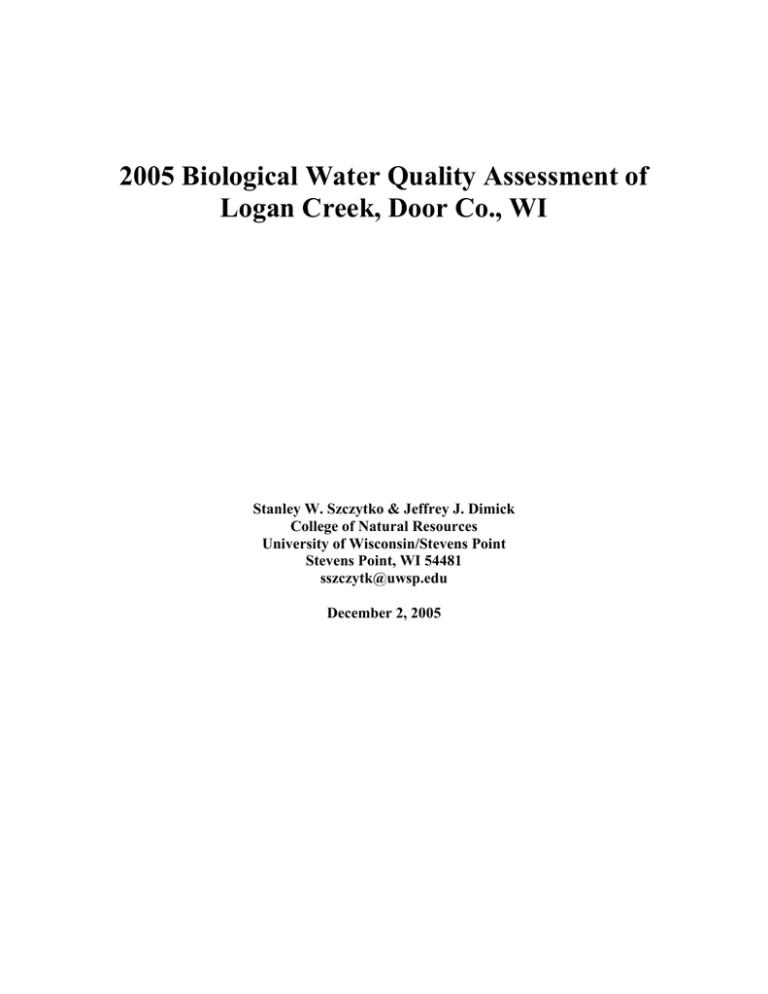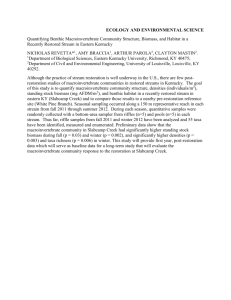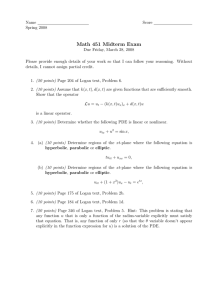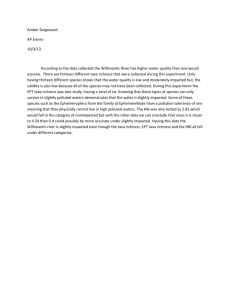2005 Biological Water Quality Assessment of Logan Creek, Door Co., WI
advertisement

2005 Biological Water Quality Assessment of Logan Creek, Door Co., WI Stanley W. Szczytko & Jeffrey J. Dimick College of Natural Resources University of Wisconsin/Stevens Point Stevens Point, WI 54481 sszczytk@uwsp.edu December 2, 2005 2005 Biological Assessment of Logan Creek, Door Co. WI 2 Background of Stream Macroinvertebrate Bioassessment The Wisconsin Department of Natural Resources (WDNR) began using the Hilsenhoff Biotic Index (HBI) (Hilsenhoff 1987, 1982, 1977) in 1979 to assess water quality of streams and rivers as part of several monitoring programs. This water quality monitoring approach continued to expand through time and currently the WDNR collects more than 400 aquatic invertebrate samples per year for stream bioassessment (Martin 2000). The procedures for sampling and laboratory processing were standardized by the WDNR in 1983, and statistical analysis procedures for applying the HBI were developed by Narf et al. (1984). Hilsenhoff (1998, 1987, 1982, 1977) developed a range of HBI values (0-10) for water quality classifications based on the degree of organic pollution used by the WDNR in their water quality assessment and monitoring programs (Table 1). The HBI uses aquatic arthropods to evaluate water quality with a numerical index that allows quantification and assessment of water quality. These organisms are ideally suited for biomonitoring for several reasons. They are common in essentially all streams, are easily collected, not very mobile, are relatively easy to identify, and have life cycles up to a year or greater (Hilsenhoff 1977). Because they are continually exposed to extremes in environmental conditions during their life cycles, they can serve as effective indicators of environmental changes. The HBI was originally developed to assess low dissolved oxygen caused by organic loading and it appears to work best for this purpose (Hilsenhoff 1987, 1982, 1977). The HBI may also be sensitive to the effects of impoundment, thermal pollution, and some types of chemical pollution (Hilsenhoff 1998). Only hydropneustic organisms are used in the calculation of the HBI, because they rely on dissolved oxygen instead of 2005 Biological Assessment of Logan Creek, Door Co. WI 3 surface air for respiration and are responsive to short term changes in stream DO. Organisms that are most sensitive to low dissolved oxygen have low tolerance values, and tolerant organisms have high tolerance values. Tolerance values for most Wisconsin aquatic macroinvertebrate species have been determined. In instances were identification to species is not currently possible, a generic tolerance value is available. Certain macroinvertebrate species can become very abundant at certain times of the year in specific microhabitats which may “swamp” a sample with unusually high numbers of particular species. This is a typically occurrence during pre-emergence periods when many species move from a dispersed riffle distributional pattern into a clumped pattern near the stream margins. In response to this problem, Hilsenhoff (1998) proposed using a modified HBI with a maximum limit of ten individuals from each species to be included in a bioassessment sample. This modification reduces problems where occurrence of certain tolerant taxa in clean streams reduces overall water quality, reduces the effects of a few intolerant taxa in slightly polluted streams, and reduces the effects of the inability to identify larvae in some genera to species. This also reduces seasonal variability and allows sampling to occur anytime with only a small decrease in sensitivity during the summer. Other metrics that have been used for water quality determinations have included the Ephemeroptera-Plecoptera-Trichoptera Index (EPT) and the Shannon’s Diversity Index. The EPT includes only individuals from the orders Ephemeroptera, Plecoptera and Trichoptera. These orders tend to have the lowest organism tolerance values and are the most sensitive to pollution. Generally the higher the number of EPT genera the more pristine the stream is ranked. There is a fairly good correlation of the EPT genera with 2005 Biological Assessment of Logan Creek, Door Co. WI 4 the HBI and water quality since they are all based to some degree on the established organism tolerance values. The Shannon Diversity index (Magurran 1988) is a measure of the richness and evenness of the genera and species found in the sample. Generally higher numbers indicate better water quality, however this index is not as well correlated with water quality as the other metrics used in this study. For example cold headwater streams typically have the best water quality of the drainage but generally have lower diversity because of the colder temperatures and limited habitat. A review of current macroinvertebrate bioassessment measures was provided by (Lillie et. al. 2003). They stress the fact that no single measure will be 100 percent effective in defining water quality; however they indicate that the HBI has the broadest capability. Clark Lake – Logan Creek Macroinvertebrate bioassessment samples were collected from Logan Creek, Door County, Wisconsin on May 15 and October 12, 2005 by Dr. Stanley W. Szczytko and Jeffrey Dimick from the University of Wisconsin/Stevens Point. An attempt was made to sample Logan Creek from near the headwaters at Lost Lake to near the outlet at Clark Lake. Sites were selected using criteria established by Hilsenhoff (1987) and used routinely by the Wisconsin Dept. of Natural Resources for rapid macroinvertebrate bioassessment sampling. After visiting all possible road crossing sites on Logan Creek appropriate sampling habitat was found at Plum Bottom Road (Upper Site), Bagnall road (Middle Site) and Loritz road (Lower Site). The Sunny Slope road site between Plum Bottom and Bagnall roads had low gradient and flow and lacked the appropriate substrate and was not sampled. The road crossing at Hwy T between Sunny Slope and Bagnall 2005 Biological Assessment of Logan Creek, Door Co. WI 5 roads had fair substrate but very low stream velocity and was not sampled. The flow and habitat at the Loritz Rd. site appeared better suited for sampling than the HWY 57 site, although it was found out later that the Loritz Rd. site typically dewaters sometime during the summer months. As a result of these field surveys three replicate samples were taken at Plum Bottom, Bagnall and Loritz roads on May 15, 2004. On October 12, 2005 these sites were also visited and all sites except the lower site at Hwy 57 had no flowing water. The Plum Bottom site had no water at all. The Loritz Road site has typically dewatered during summer months over the last few years according to Paul Schumacher (personal communication). Summer 2005 was an exceptionally dry summer and many headwater streams we checked in Door County ceased flowing (e.g. Gilson Creek, Brown County) during late July and August. As a result of the dewatering only the Hwy 57 site had the appropriate flow and substrate for 3 replicate samples required for rapid bioassessment sampling in October 2005. Methods Field Procedures: Samples were collected in the field using standard WDNR protocols (Hilsenhoff 1998, 1987) for rapid bioassessment. Three replicate kick samples were taken at each site from riffles with appropriate current and substrate. Riffle habitats consisted of a gravel substrate subjected to moderately fast currents and partially exposed at the surface. A rectangular 48x24 cm frame kick net with a 600 um mesh bag was used to collect all samples. Samples were preserved on-site with 80% isopropyl alcohol, and re preserved again with 80% isopropyl alcohol in the lab within five days. For each sample, water depth, current velocity, and visual in-stream characteristics such as length of stream 2005 Biological Assessment of Logan Creek, Door Co. WI 6 bank erosion, point source discharge type and amount, and turbidity were also recorded. A hydrolab sonde probe was used to measure pH, temperature and dissolved oxygen concentrations to the nearest 0.1 mg/L. The hydrolab probe was calibrated for DO using atmospheric oxygen and barometric pressure, and calibrated for pH using known standards (pH = 3, 7, and 10). Alkalinity was measured in the field using a hach kit (model AL-368). A Marsh-McBirney Model 201D portable electronic current meter was used to measure velocity to the nearest 0.01 ft/sec. A Garmin Map 76S GPS unit was used to record geo-locational data. Lab Procedures: In the lab, each sample was rinsed with water and distributed evenly in a clear Pyrex pan with a grid of 15 equal 5x5 cm permanent markings. A random number table was used to select a starting square, and each successive square (from right to left) was picked until a minimum of 125 arthropods with established HBI tolerance values (Hilsenhoff 1982) were sorted. All organisms were removed from the final square, even when the minimum number had been achieved, to eliminate bias of selecting only larger or more visible arthropods. A dissecting microscope and fiber optic light source, along with selected taxonomic keys, were used to identify all non-Chironomidae organisms to the lowest practical taxonomic unit. Chironomidae larvae were mounted on microscope slides in CMC-10® mounting medium (Master’s Chemical Company, Inc.) and allowed to clear for a minimum of five days. The larvae were then counted and identified to the lowest practical taxonomic level using a compound binocular microscope. All taxonomic and field data were entered into the BUG database program 2005 Biological Assessment of Logan Creek, Door Co. WI 7 developed at the University of Wisconsin-Stevens Point (Szczytko 1999, 1996). The BUG program calculated an HBI, a modified HBI adjusted for a maximum of 10 individuals of each taxon (Hilsenhoff 1998, 1988, 1982). Results Due to the finding that all samples taken in this study had a high degree of family, genus and species dominance by Asellidae Caecidotea intermedia (79-40%), Simuliidae Simulium verecundum (36%) or Nemouridae Amphinemura delosa (81-48%) (Table 2). It appears that the best indicator of water quality for Logan Creek is the HBI max 10 and this index was used to determine the water quality classification at all sites. The reasons for this are discussed previously. In most cases using the HBI max 10 resulted in a one category better water quality classification compared to the standard HBI. Historical Samples Historical macroinvertebrate data were obtained for comparative purposes from the StateWide Macroinvetebrate Database maintained by the University of Wisconsin/Stevens Point. Historic samples were taken on Nov. 11, 1978, Nov. 3 and April 11, 1987, and April 11 and Nov. 7, 1990 by WDNR personnel at the Hwy 57 bridge site on Logan Creek, Door County, WI. On Nov. 11, 1978 the single sample taken indicated that this site was ranked as having either good (standard HBI) or very good (HBI max. 10) water quality (Tables 1 & 2). During Nov. 1987 the mean (4.763 HBI max 10) of the three samples taken indicate that this site was ranked as good. On April 11, 1990 this site was ranked as fair by both the HBI and HBI max 10. On November 7, 1990 this site was ranked as good by both the HBI and HBI max 10. Diversity values ranged from a high of 2.397 to a low of 1.005 and the count of EPT taxa ranged form 0 to 4 (Table 2). 2005 Biological Assessment of Logan Creek, Door Co. WI 8 Hilsenhoff (1988) recommended that macroinvertebrate samples be taken in the fall before November so data from these samples must be view as suspect. 2005 Data Plum Bottom Road The sampling location at the Plum Bottom Road site was N440 59.362’ W870 15.429’ (Table 4). The appropriate sampling substrate was formed solely by the rubble surrounding the bridge. The sampling site was ca. 0.74 mi below Lost Lake. Spawning Iowa darters (Etheostoma exile (Girard)) were noted at this site during the time of sampling. The average depth for the 3 replicate samples was 1.93 ft, the average velocity was 0.49 ft/sec, width was 7.83 ft, stream temperature was 12.60 C, dissolved oxygen was 8.84 mg/l, alkalinity was 153.9 mg/l, conductivity was 43 umhos/cm and pH was 7.6 (Table 5). The mean HBI max 10 of the three replicate samples ranked this site has having “fair” water quality. The standard HBI ranked this site has having “fairly poor” water quality (Table 6). The mean diversity index for the three samples was 3.906 (SD 1.655, range 2.857 - 5.813) and the mean EPT genera count was 3.00 (SD – 0.0, range 0) (Table 7). All samples were dominated (41 – 44%) by Asellidae Caecidotea intermedia which is a fairly tolerant species with an established tolerance value of 8 (organism tolerance values range from 0 – most intolerant to 10 – most tolerant) (Table 2). Bagnall Road The sampling location at the Bagnall Road site was N440 58.012’ W870 14.241’ (Table 4). This site offered the best quality riffle site of all sites sampled. The average 2005 Biological Assessment of Logan Creek, Door Co. WI 9 depth for the 3 replicate samples was 0.30 ft, the average velocity was 0.78 ft/sec, width was 14.75 ft, stream temperature was 13.90 C, dissolved oxygen was 8.95 mg/l, alkalinity was 171 mg/l, conductivity was 54.3 mhos/cm and pH was 8.0 (Table 5). The mean HBI 10 max of the three replicate samples ranked this site has having “very good” water quality. The standard HBI also ranked this site has having “very good” water quality (Table 6). The mean diversity index for the three samples was 1.966 (SD - 0.086, range 1.878 - 2.049) and the mean EPT genera count was 3.333 (SD – 1.582,range 2-5) (Table 8). Two samples were dominated by the families Simuliidae (Diptera – 72-89%) and one sample was dominated by the family Nemouridae (Plecoptera – 64%). The genus Simulium (Diptera) dominated 2 samples (51-67%) and the genus Amphinemura (Plecoptera) dominated one sample (64%). The species delosa (Plecoptera) dominated 2 samples (48-64%) and the species verecundum (Diptera) dominated one sample (36%) (Table 2). Loritz Road The sampling location at the Loritz Road site was N440 57.273’ W870 13.038’ (Table 3). This site was much narrower than the other sites and had less discharge. There was less canopy cover than the other sites and the section sampled which was west of Loritz Road very straight and nearly channelized. There was evidence of extreme scouring along the banks due to spring high water conditions. This site appears to have the greatest potential for agricultural influences of all sites due to the proximity of the fields to the stream bank and is known to dewater in the summer months. The average depth for the 3 replicate samples was 0.38 ft, the average velocity was 0.62 ft/sec, width was 5.0ft, stream 2005 Biological Assessment of Logan Creek, Door Co. WI 10 temperature was 15.50 C, dissolved oxygen was 9.42 mg/l, alkalinity was 171 mg/l, conductivity was 56.3 mhos/cm and pH was 8.5 (Table 4). The mean HBI max 10 of the three replicate samples ranked this site has having “good” water quality. The standard HBI ranked this site has having “very good” water quality (Table 6). The mean diversity index for the three samples was 2.123 (SD 0.581, range 1.692 - 2.784) and the mean EPT genera count was 3.667 (SD – 0.577, range 3 - 4) (Table 8). All samples were dominated by the plecopteran Nemouridae, Amphinemura delosa (49-81%) (Table 2). This species is fairly intolerant to pollution and has a tolerance value of 3.0. Highway 57 The sampling location at the Highway 57 (October 11, 2005) site was N440 57.792’ W870 13.354’ (Table 3). The appropriate sampling substrate was formed solely by the rubble surrounding the bridge. The stream reaches above and below the sampling site widened abruptly and significant in stream vegetation beds were noted in the widen sections. This site was ca. 0.75 mi above Clark Lake. Marl deposits were noted in slower reaches of the stream at this site. The average depth for the 3 replicate samples was 0.46 ft, the average velocity was 0.47 ft/sec, width was 6.25 ft, stream temperature was 10.70 C, dissolved oxygen was 8.18 mg/l, alkalinity was 239.4 mg/l, conductivity was 57.6 mhos/cm and pH was 7.3 (Table 4). The mean HBI max 10 of the three replicate samples ranked this site has having “Good” water quality. The standard HBI ranked this site has having “fair” water quality (Table 6). The mean diversity index for the three samples was 1.547 (SD - 0.469, range 2005 Biological Assessment of Logan Creek, Door Co. WI 11 1.005 – 1.825) and the mean EPT genera count was 2.000 (SD – 1.000, range 1 – 3) (Table 8). Two samples were dominated by the families Asellidae (Isopoda – 65-79%) and one sample was dominated by the family Chironomidae (Diptera – 59%) (Table 2). The species intermedia (Isopoda) dominated all samples (56-79%). As mentioned above this species has a tolerance value of 8.0. Discussion Logan Creek occurs in a karst outcropping and is well pH buffered which is supported by the in-stream pH and alkalinity levels measured in this study. The lowest pH of 7.3 was found at the Hwy 57 site which was surprising in light of the marl deposits observed. The entire stream can be classified as stream order 2 and is ca. 6.0 mi long (Cummins 1974). Based on the mean water quality rankings of the individual sites Logan Creek can be generally classified by the HBI max 10 as having “fair” to “good” water quality. It appears that water quality improves downstream from the Plum Bottom Rd. site which is ca. 1 mile downstream of Lost Lake. The stream at the outlet of Lost Lake is shallow wide and marshy which probably contributes to organic loading and decreased dissolved oxygen levels at certain times of the year. This is also supported by the dominance of the macroinvertebrate community by Caecidotea intermedia which is an Isopod that feeds on decaying organic matter. There was no obvious trend of decreasing water quality downstream that is typical of many streams. The best water quality (good – very good) was found at the Bagnall and Loritz Road sites even though it was apparent that the stream was losing water at 2005 Biological Assessment of Logan Creek, Door Co. WI 12 Loritz Road . The water quality ranking at the Hwy 57 site during October was rated as fair but this could have been due to the extreme low water conditions and presumably higher temperatures that occurred during the summer of 2005. One historic sample taken on November 7, 1978 and one taken on November 3, 1987 ranked this site as having very good water quality. In this study the mean count of EPT genera varied from 0.333 (Hwy 57) to 3.667 (Table 7). There was not a good correlation of the EPT with the HBI values in this study however comparisons of EPT counts with HBI values from other Door County Wisconsin streams also did not show good correlations (Table 8). The Shannon Diversity Index in this study varied from 1.966 (Bagnall Road) to 3.906 (Plum Bottom Road) (Table 7). Similar to the EPT comparisons the diversity index did not have a good correlation with the HBI and water quality. This was also true for comparisons from other Door County Wisconsin streams (Table 8). Hilsenhoff (1977) also found similar results comparing diversity and HBI values in his study of 53 Wisconsin streams. He found that the best water quality stream in the state was ranked only 32 out of 53 in terms of diversity. These conclusions emphasize the importance of using the EPT and diversity indices as supportive data to the HBI and appear to offer little additional information for Logan Creek. The Logan Creek watershed is unique in its geology when generally compared to most streams in Wisconsin. Since it is a small stream (steam order 2 – ca. 6.0 mi length) with low discharge it should be considered fragile and susceptible to impairment. It appears that the two main potential threats to this watershed are water quantity and lost of riparian area due to development and agriculture. Any land use change that draws on the 2005 Biological Assessment of Logan Creek, Door Co. WI 13 groundwater aquifer in a significant way may have detrimental effects on this small watershed. Additional development along the shoreline of Lost Lake and increased use may also affect the downstream water quality of Logan Creek. There is also some evidence that this watershed may support the Hine’s Emerald Dragonfly (Somatochlora hineana) which is a federally endangered species. This dragonfly does occur in nearby areas and appears to be associated with karst geological outcroppings. In light of these facts this watershed should be protected from development and monitored closely in the future. 2005 Biological Assessment of Logan Creek, Door Co. WI 14 Literature Cited Cummins, K.W. 1974. Structure and function of stream ecosystems. Bioscience 24:631-641. Hilsenhoff, W.I. 1998. A modification of the biotic index of organic stream pollution to remedy problems and to permit its use throughout the year. The Great Lakes Entomologist. 31:1-12. Hilsenhoff, W.L. 1987. An improved biotic index of organic stream pollution. Great Lakes Entomologist. 20:31-39. Hilsenhoff, W.L. 1982. Using a biotic index to evaluate water quality in streams. Wisconsin Department of Natural Resources. Technical bulletin No. 132:22 pp. Hilsenhoff, W. L. 1977. Use of arthropods to evaluate water quality of streams. Wisconsin Department of Natural Resources. Technical bulletin No. 100: 15 pp. Lillie, R.A.; Szczytko, S.W.; and Miller M.A. 2003. Macroinvertebrate data interpretation manual. WI Dep. Natur. Res. Pub SS 965-2003 58pp. Magurran, A.E. 1988. Ecological diversity and its measurement. Princeton Univ. Press, Princeton, NJ. 179 pp. Martin, R. 2000. Wisconsin Water Quality Report to Congress. Department of Natural Resources Wisconsin. Bureau of Watershed Management. PBU-WT-254-2000. 2005 Biological Assessment of Logan Creek, Door Co. WI 15






